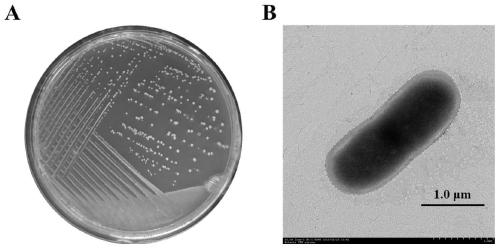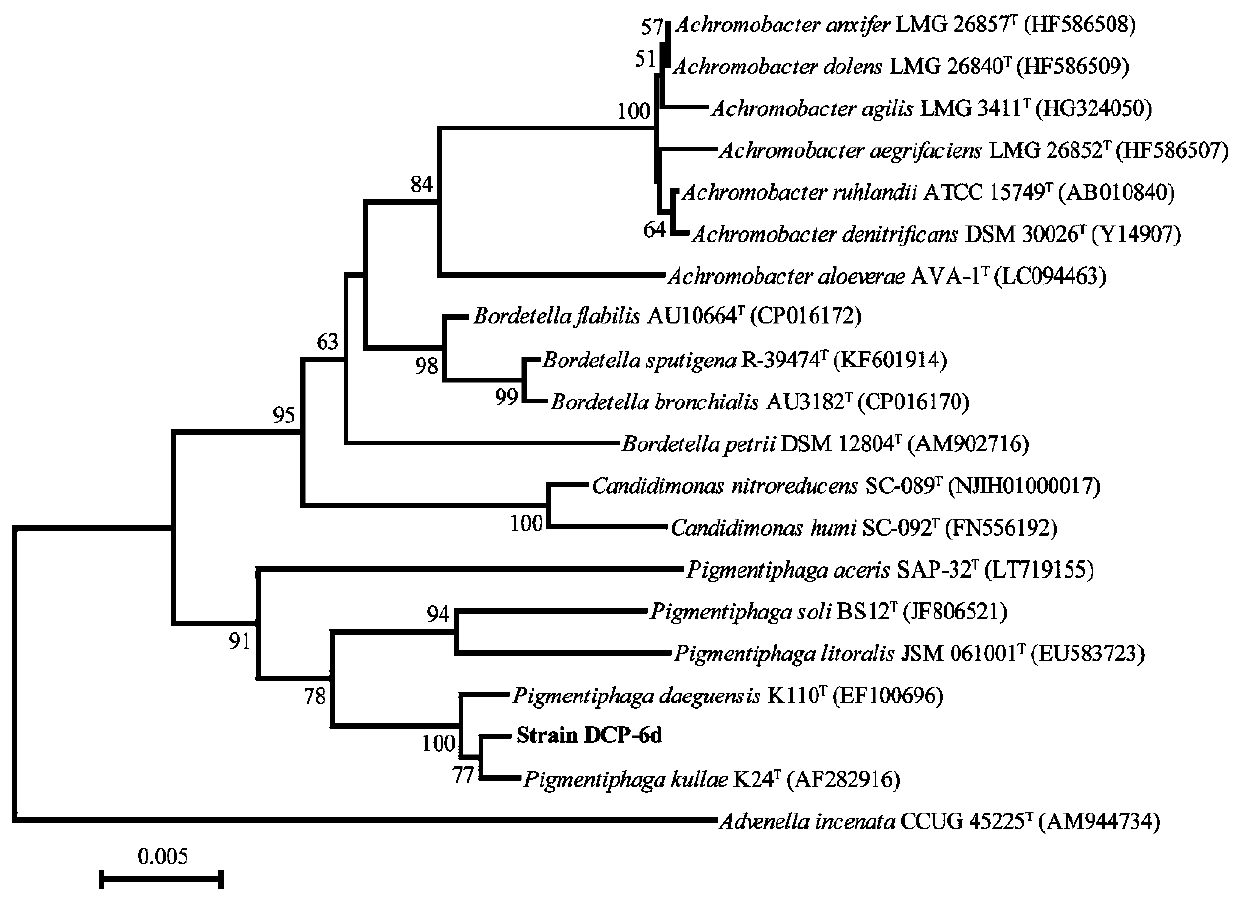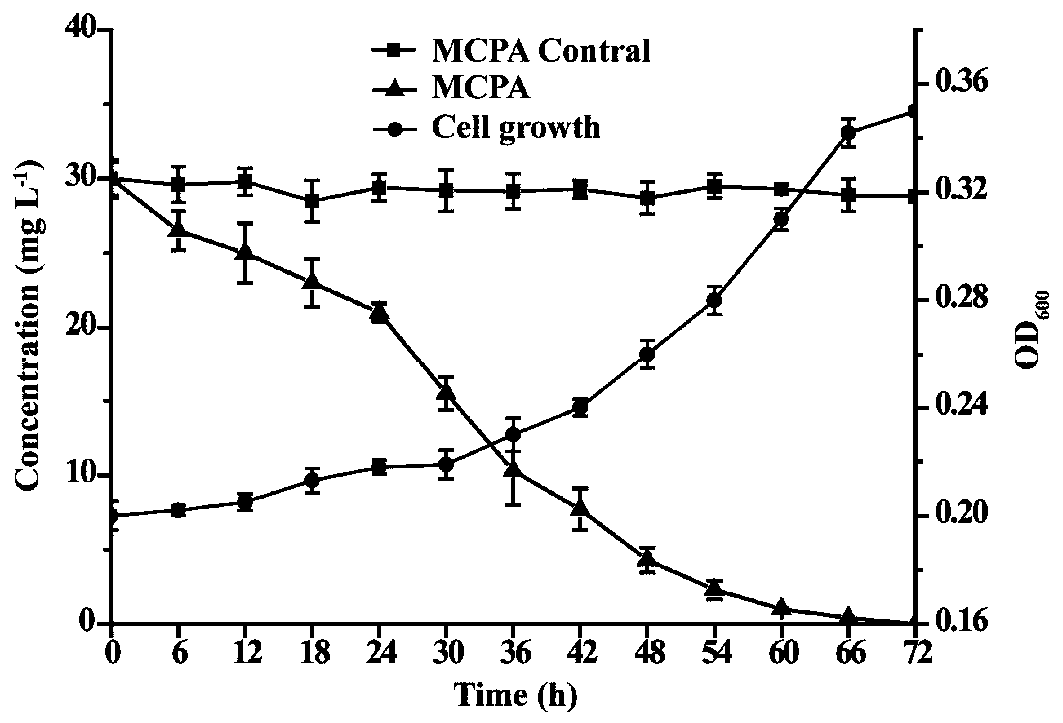Degrading strain for dimethyltetrachloro (MCPA) of phenoxyacetic acid herbicide and microbial agent produced by degrading strain
A technology of phenoxyacetic acid and dimethyltetrachloride, which is applied in the bio-high field, can solve the problems of phytotoxicity of the next crops, and achieve the effects of low production and use costs, pollution control and good repair effect
- Summary
- Abstract
- Description
- Claims
- Application Information
AI Technical Summary
Problems solved by technology
Method used
Image
Examples
Embodiment 1
[0032] The isolation and identification of embodiment 1 bacterial strain
[0033] The invention provides a bacterial strain capable of efficiently degrading MCPA and the bacterial agent produced therefrom. The bacterial strain used is a Gram-negative bacterium DCP-6d, which is isolated from the soil of a pesticide factory in Nanjing, Jiangsu. The specific isolation and screening methods for strains are as follows:
[0034] Take 10.0g contaminated soil sample and add to 100mL containing 30mg L -1 Inorganic salt (hereinafter referred to as MM) medium of MCPA, 30 ℃, 150rpm shaker culture 7d, with 15% inoculum size (v / v) transferred to fresh medium through the same treatment, continuous enrichment culture four times . Ultraviolet spectrophotometer was used to detect the degradation of the fifth generation enrichment solution. The effective fifth-generation enrichment solution containing 30mg L -1 MCPA was diluted and coated on MM solid medium, and cultured at 30°C for 5 days. ...
Embodiment 2
[0036] Embodiment 2 laboratory degradation experiment
[0037] 2.1 Growth utilization and degradation of MCPA by strain DCP-6d
[0038] Detection of DCP-6d by high performance liquid chromatography: take 3mL sample, centrifuge at 12,000rpm for 5min, carefully absorb the supernatant, add 25% hydrochloric acid, and adjust the pH to about 3.0. Then, extract with an equal volume of dichloromethane, remove water with anhydrous sodium sulfate, take 2mL of dichloromethane and blow dry, then redissolve in 0.5mL of methanol, filter with an organic phase filter membrane with a pore size of 0.22 μm, and detect by HPLC. Detection conditions: Shimadzu RID-10A is the high-performance liquid chromatograph; the chromatographic column is a C18 reversed-phase column with a size of 250mm×4.6 mm; the column temperature is 40°C; the mobile phase is methanol:water:acetic acid (80:20:0.5, V :V:V), the flow rate is 1.0mL min L -1 ; The detection wavelength is 220nm and 235nm.
[0039] The bacteria...
Embodiment 3
[0051] Embodiment 3 bacterial agent preparation
[0052] The original seed of the halogenated phenol-degrading strain DCP-6d of the present invention is activated on a petri dish, and inoculated on the inclined surface of a test tube for later use. The test tube was inoculated in 200mL LB medium (LB medium formula: peptone 10g L -1 , yeast powder 5g L -1 , NaCl 5g L -1 , pH 7.4) in a 1,000mL shake flask, cultured with constant temperature shaking until the logarithmic phase, ready to inoculate the primary seed tank. The first-level seed tank is 50L, the feeding volume is 40L, and the medium formula is: glucose 8g L -1 , yeast extract 5g L -1 , K 2 HPO 4 1g L -1 , NaCl 5gL -1 , CaCO 3 2g L -1 , MgSO 4 0.2gL -1 , soybean oil 0.1% (v / v), pH value 7.5; after feeding, high-pressure steam sterilization, after cooling to 30 ℃, inoculate 50 L first-level For seed tanks, cultivate until the logarithmic growth phase, the stirring speed is 220rpm, and the sterile air flow...
PUM
 Login to View More
Login to View More Abstract
Description
Claims
Application Information
 Login to View More
Login to View More - R&D
- Intellectual Property
- Life Sciences
- Materials
- Tech Scout
- Unparalleled Data Quality
- Higher Quality Content
- 60% Fewer Hallucinations
Browse by: Latest US Patents, China's latest patents, Technical Efficacy Thesaurus, Application Domain, Technology Topic, Popular Technical Reports.
© 2025 PatSnap. All rights reserved.Legal|Privacy policy|Modern Slavery Act Transparency Statement|Sitemap|About US| Contact US: help@patsnap.com



